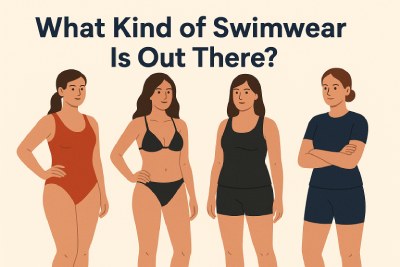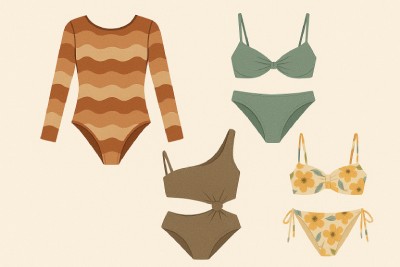Finding the Best Swimwear for Every Body Type
Swimwear isn't just something we throw on for a beach trip—it's a wardrobe essential that makes us feel ready for fun in the sun (or laps in the pool). Whether you're planning a tropical vacation, diving into a new workout routine, or just looking to update your summer style, the right swimsuit can make all the difference.
At its core, swimwear is designed for use in water. It's built from stretchy, quick-drying materials that move with your body and keep their shape. But beyond function, it's also a way to express your style and feel good in your skin, no matter your shape or size.
What Kind of Swimwear Is Out There
Let's be honest—shopping for swimwear can feel overwhelming. There are so many styles, fits, and cuts, and what works for one person might not work for another. Here's a breakdown of the most common options:

- One-piece swimsuits are timeless. They're a great choice if you want more coverage or need something that stays put during swimming. Many styles now come with supportive panels, openbacks, and fun necklines, so they don't feel outdated at all.
- Bikinis are all about mixing and matching. Want a padded top and high-waisted bottom? Go for it. Prefer triangle cuts and tie-sides? That works, too. Bikinis allow you to create your own look and adjust the coverage according to your mood.
- Tankinis offer a bit more coverage on the tummy without sacrificing comfort. They're perfect if you like the convenience of a two-piece but want something a little more modest.
- Swim trunks and board shorts are the go-to choice for men, but women also wear them for surfing or sporty beach days. They're light, fast-drying, and easy to wear over a swimsuit.
- Jammers and briefs are common in competitive swimming. They fit close to the body and help reduce drag in the water—great for when speed matters.
- Rash guards and long-sleeved swimsuits offer extra sun protection. They're often worn by surfers, kids, or anyone spending long hours outdoors.
There's truly something for everyone—you need to find the suit that feels right for you.
How to Choose Swimwear for Your Body Type
This part often trips people up, but it doesn't have to be complicated. Choosing a suit that suits your body isn't about hiding what you don't like—it's about finding something that makes you feel confident and comfortable.
If your hips are wider than your upper body (think pear-shaped), go for suits that draw the eye upward. Bright colours, ruffled tops, or halter necks can balance your shape. Pair that with a darker or more minimal bottom for a flattering combo.
If you carry more weight in your midsection (apple-shaped), look for suits with tummy control panels or wrap designs. A deep V-neck or colour-blocked suit can create a longer, more defined silhouette without feeling tight.
If you're hourglass-shaped (similar to bust and hip size with a smaller waist), the key is to show off your curves without sacrificing support. Try high-waisted bikinis, belted one-pieces, or anything that highlights your waistline.
For those with athletic builds (straighter figures or less defined curves), details can help create a more defined shape. Think ruching, side ties, bold prints, and cut-outs. A triangle bikini or low-rise bottom can also add softness to your silhouette.
If you're plus-size or curvy, support is your best friend. Look for suits with wide straps, built-in bras, and fabrics that gently shape the body. There are numerous stunning plus-size options available today that offer comfort and style in equal measure.
The biggest tip? Don't just go by the label or a model's photo. Try different styles, move around in them, and pay attention to how you feel. A good suit should stay in place, support you in the right spots, and make you feel like yourself.
The Fabrics That Make It Work
Not all swimwear fabrics are created equal, and that matters more than you might think.
Most suits are made with some combination of nylon, polyester, and spandex. Here's what they do:
If you're looking for a long-lasting suit (especially for lap swimming), opt for one with a higher polyester content. If comfort is your priority and you're swimming casually, nylon and spandex blends are perfectly fine.
Also, look for details that enhance comfort, such as double linings to prevent see-through issues, adjustable straps for a better fit, and flat seams that won't chafe.
Swimwear Trends to Watch in 2025
The 2025 swimwear scene is all about confidence, comfort, and sustainability. Here's what's trending:

- Eco-friendly fabrics are taking centre stage. More brands are using recycled materials—think plastic bottles turned into soft, stretchy swimwear. Not only do these suits look great, but they also help reduce waste.
- One-shoulder and asymmetrical designs are big this year. They offer a modern twist while still providing support. You'll also see lots of high-cut legs, square necklines, and retro vibes making a comeback.
- Textured fabrics—like ribbed, crinkled, or smocked styles—are everywhere. These materials add a bit of visual interest and feel more forgiving on the body, which is always a win.
In terms of colour, we're seeing earthy tones, such as olive and burnt orange, mixed with soft pastels and bright tropical prints. If you're into mixing patterns or colours, many brands now let you build your own set with customisable pieces.
Most importantly, the industry is finally embracing inclusive sizing and body diversity. Whether you're petite, tall, curvy, or anywhere in between, there's more choice than ever. Some brands even offer gender-neutral suits or adaptive styles for individuals with disabilities—swimwear is truly evolving to include everyone.
Keep Your Suit Looking Like New
A great swimsuit can last for years if you take care of it. Here's how:
- Always rinse your suit after swimming. Whether it's saltwater, chlorine, or sweat, rinsing with cool water helps prevent damage.
- Hand wash your suit gently with a mild detergent. Avoid machine washing, which can stretch and fade the fabric.
- Skip the dryer. High heat can ruin the stretch in your swimsuit faster than you'd think. To keep it in shape, skip the tumble dryer and let it rest flat in the shade. And whatever you do, don't hang it by the straps—it's a surefire way to stretch them out before their time.
- Rotate your swimwear if you swim a lot. Giving your suit time to rest between wears helps it bounce back.
- Avoid rolling it up in a towel or leaving it in your gym bag. That creates a damp environment that leads to mildew and fading.
It takes just a few extra minutes to care for your swimwear—and trust us, it's worth it.
FAQ
What's the best swimsuit for lap swimming?
For serious swimming, you want a suit that stays in place. Women typically go for streamlined one-pieces with racerback or cross-back straps. Men can choose jammers or briefs that reduce drag. Skip the frills and focus on performance fabrics, such as chlorine-resistant polyester.
How do I figure out my swimsuit size?
Start with a measuring tape and note down your bust, waist, and hip measurements. Compare them to the brand's sizing chart—don't assume your usual size will work because swimwear sizing can vary. If you're in between sizes, choose the one that offers adjustable straps or ties. Better to have a snug fit than one that sags in the water.
Can I wear my swimsuit in a hot tub?
You can—but expect some wear and tear. The heat and chemicals in a spa can break down fabrics more quickly, especially if your suit is made with a high percentage of spandex. If you have a favourite suit, consider keeping it for beach days and using an older one in the hot tub. Either way, rinse it well afterward.
What's the deal with chlorine-resistant fabric?
If you frequently swim in chlorinated pools, chlorine-resistant suits are your best option. These are usually made with polyester or a polyester blend that doesn't stretch out or fade as fast. Regular swimwear with high spandex content will wear down quickly with repeated exposure to pool chemicals.
